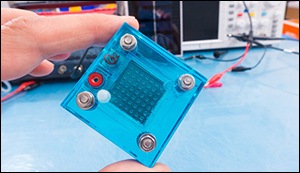Creating longer-lasting fuel cells
27. 9. 2017 | Washington University in St. Louis | source.wustl.edu
Fuel cells could someday generate electricity for nearly any device that’s battery-powered, including automobiles, laptops and cellphones. Typically using hydrogen as fuel and air as an oxidant, fuel cells are cleaner than internal combustion engines because they produce power via electrochemical reactions. Since water is their primary product, they considerably reduce pollution.
One issue that impacts the lifetime of the fuel cell is the oxidation, or breakdown, of its central electrolyte membrane. The process leads to formation of holes in the membrane and can ultimately cause a chemical short circuit.

An engineering team at Washington University in St. Louis has developed a new way to take a look at the rate at which oxidation occurs. Using fluorescence spectroscopy inside the fuel cell, they are able to probe the formation of the chemicals responsible for the oxidation, namely free radicals, during operation. The technique could be a game changer when it comes to understanding how the cells break down, and designing mitigation strategies that would extend the fuel cell’s lifetime.
Read more at Washington University in St. Louis
Image Credit: Shutterstock
-jk-




